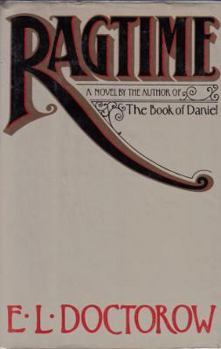Ragtime
Select Format
Select Condition 
Book Overview
Selected by the Modern Library as one of the 100 best novels of all time Published in 1975, Ragtime changed our very concept of what a novel could be. An extraordinary tapestry, Ragtime captures the... This description may be from another edition of this product.
Format:Hardcover
Language:English
ISBN:0394469011
ISBN13:9780394469010
Release Date:June 1975
Publisher:Random House (NY)
Length:270 Pages
Weight:0.13 lbs.
Customer Reviews
5 ratings
America's Storyteller
Published by Thriftbooks.com User , 18 years ago
E.L Doctorow's highly readable novels combine history, imagination, character development, a sense of time and place and beautifully controlled and paced writing. Doctorow's relatively early novel, "Ragtime" (1974) remains his best-known work. The book is a delight to read, moves with the feel of ragtime piano, and has a light happy surface. Yet the book combines many disparate threads and stories, a wealth of historical and fictional characters thrown together, and offers an unsettling vision of the United States at the turn of the century, c.1906. There is a complex, multi-layered vision at work here. The story is told in the first person in the words of Young Boy, whose parents are Father, a successful manufacturer of fireworks and flags in New Rochelle, New York, and Mother, an increasingly frustrated houswife. Mother has a brother, referred to as "Mother's younger brother" who is infatuated with a notorious, (and historical) beauty and femme fatale of the day, Evelyn Nesbit, and who becomes an expert in the use of explosives in Father's fireworks business. The story of this family slowly intertwines with that of a different American family -- Tateh, a Jewish immigrant from East Europe who at the beginning of the book is struggling as a silouette artist on Hester Street New York City, has young daughter, and Mameh, who through poverty and desparation has abandoned the family for a life of prostitution. There is a third fictitious American intertwined in the story. Sarah is a young (18 years old) black woman who has a young child that come to live with Mother while Father is away exploring the North Pole with Peary. Mid-way in the novel, we meet the baby's father and Sarah's suitor, an older black man and a pianist named Coalhouse Walker. Coalhouse has studied ragtime with Scott Joplin. The book is redolent with Joplin's music including "Maple Leaf Rag" and "Wall Street Rag." Coalhouse, in his dignity and his violent rage, quickly becomes the chief protagonist of the book. Doctorow has resurrected the character of Coalhouse Walker; and as a much younger man he plays a prominent role in his most recent novel, "The March" (2005), a fictional retelling of Sherman's march through Georgia and the Carolinas in the Civil War. But these characters and their interlocking stories are only a part of "Ragtime". Doctorow threads their stories in stunningly with stories of historical figures from early 20th Century America. The characters we meet include the escape artist, Harry Houdini, the anarchist Emma Goldman, J.P. Morgan, Henry Ford, Booker T. Washington, Sigmund Freud, Theodore Roosevelt, Scott Joplin, Evelyn Nesbit, her cuckolded husband, Harry Thaw, and her lover, the architect Stanford White, and several others. Some of these people have prominent roles in the stories while others have cameo parts. But their personalities in virtually every case shine through Doctorow's prose. For all the elan, rambunctiousness, and lyricism of
The Ragtime Era Comes Alive with Pain, Drama, and Hope
Published by Thriftbooks.com User , 18 years ago
A powerful evocation of the pre-World War I period in America. Doctorow painfully dramatizes (as well as personalizes) the social abuses of the latter 19th Century but still manages to re-affirm the possibilities inherent in the American dream. The focus is on a single, not-so-typical American family, although such luminaries of the era as Harry Houdini, Henry Ford, and Pierpont Morgan also appear as minor characters. Father goes on an expedition to the North Pole and comes back with more than he bargained for. Mother's brother becomes embroiled in a torrid love affair with a notorious beauty who has played a significant role in a famous murder case. And the main plot line shows how the entire family is endangered (and has their lives dramatically changed) by their involvement in a black family's fight for due process. But this isn't as small a novel as "To Kill a Mockingbird". Doctorow's focus on the family and the personal side of these events is only the lynchpin that holds together a sweeping, wide-ranging look at turn-of-the-century society as a whole. Perhaps not since "War and Peace" has one novel so successfully combined the intimately personal with the grand scope of history. Politics, racism, sexual mores, yellow journalism, corruption, the entertainment revolution, terrorism, labor relations: all pass under Doctorow's analytical gaze. Easy to read and not overlong, this would be a great book for high school students to read in learning about pre-War American society, if it weren't for the sexual content, which is higher than average for a work of this kind. As it is, this novel is episodic enough that teachers could assign excerpts without killing the power of the whole book. Very highly recommended.
A Riff on America at the Turn of the 20th Century
Published by Thriftbooks.com User , 19 years ago
Even before the Broadway musical and the film, Ragtime was E.L. Doctorow's best known work, a celebrated novel that combines the syncopation of ragtime and the literary sensibilities of a writer intrigued by history as literary device. Set primarily in Westchester County's New Rochelle but also in New York City and, briefly, Massachusetts, the novel follows the stories of real and fictional characters as they move from innocence to disillusionment, from peace time to the beginnings of racial conflict and World War I. Because the novel contains so many stories, some as short as a few pages (in the case of Freud) and some woven throughout the entire novel, describing the plot of the book is a challenge. The author primarily follows the lives of a New Rochelle family (Father, Mother, Younger Brother, and the Little Boy) as they navigate changing times. Father accompanies Peary on his exploration to the North Pole. Mother takes in a young black woman, Sarah, and her newborn, an impulsive act which leads to the introduction of ragtime pianist Coalhouse Walker and his simple demands which escalate into violence. Younger Brother becomes infatuated with the celebrated beauty Evelyn Nesbit, which in turn leads to his association with anarchist Emma Goldman. Harry Houdini's car breaks down in front of their house, and the novel enters his story as well. The family acts as a touchstone for the disparate stories of a generation. Meanwhile, the story of a counterpart family - Mameh, Tateh, and the Little Girl - unfolds in the ghetto, where the Jewish immigrant family struggles for survival. Unbeknownst to both families, their stories are linked by those of the others. In syncopated prose that dissipates partway through the novel as the short age of ragtime gives way to jazz, Doctorow manages to infuse irony in short, seemingly unrelated sentences: "Everyone wore white in the summer. Tennis racquets were hefty and the racquet faces elliptical. There was a lot of sexual fainting. There were no Negroes." Since the novel is about the loss of the naiveté that gives birth to such generalizations, this kind of set-up allows for the numerous tales that shoot off in different directions. The complicated novel is not demanding to read, although the huge cast of characters and the emphasis on history makes emotional identification with the characters difficult. If readers look at this novel as an Impressionistic look at life at the beginning of the 20th century, they will find more satisfaction than if they regard it as the story of Little Boy's family. The coherence of this novel comes from the brackets of an era and not from a tidy relation among the plots. I highly recommend this influential novel for serious readers and students of literature.
A Look at Factual History Through a Fictional Story
Published by Thriftbooks.com User , 23 years ago
This book is very amusing, presenting an interesting story as well as portraying nonfictional characters (such as H. Ford, J.P. Morgan,Evelyn Nesbit,and Harry Houdini) in their true identity. One gets to experience the early century and pre-Great War era. Each chapter allows the reader to enter a life of character all intermingled with one plot. As one reads, the reader experiences the times as an African American, an immigrant, and rich businessmen. What I enjoyed most was the immigrant (Tateh & Daughter) which reminded me of my Great Grandmother's trip into America for the first time. After reading, I did background research on many characters. For what reason? to see if Doctrow was telling the truth about the nonfictional characters, such as J.P. Morgan. It turns out that Doctrow was on the dot with all characters, which shows the hidden secrets of people we thought we knew. I find this book very entertaining. Although not recommended for anyone under the age of 16 for some sexual content and vivid descriptions, I think anyone of any age old enoguh, would enjoy the read. It is a very interesting and a page turning history lesson as well as drama. After reading consider getting the CD for the musical, which very precisely follows the book.
a major modern novel
Published by Thriftbooks.com User , 23 years ago
I would differ slightly with Eddie P.(who's insights I appreciate) who likened the novel to Fitzgerald's or Lewis' and say it has more in common with John Dos Passos' USA Trilogy. The vignettes Doctorow draws for us have a great deal in common, I believe, with Dos Passos' snapshots. In answer to Banger's question about why this time period, I would suggest that this is an era that is generally regarded in the American historical consciousness as being primarily bucolic and carefree. The nation, relatively innocent, having shaken off the aftereffects of the civil war, has recently won the spurious Spanish-American war, and is generally revelling in a sense of purpose and civility. What Doctorow is suggesting is that this serene surface was already infected, with a host of social ills festering beneath it. A shift was occuring that would lead to labor riots, race riots, change in mores (sexual attitudes), loss of faith in institutions, etc. that would define the 20th century. If this were all of Doctorow's plan however, it would have been interesting Sociology, but a pretty boring novel. Doctorow is above all an interesting storyteller. He knows how to keep a plot moving and how to invest it with enough intellectual hardware to make the reader feel that his/her time has been worth the effort. He can bring a scene to life with a few fresh (never shopworn) details. He doesn't spend a great deal of time elabortaing over these details, as James or Wolfe do, but he makes the reader just as cognizant of them. A few brushstrokes and we are there. His writing is cinematic, in that we can "see" the scene he is depicting, without burdening us with excess verbiage. This is the hallmark of a really good author. Ragtime is a primary example of this kind of shorthand acumen. The novel flashes by as seen in a kinescope. I, for one, was delighted I had inserted my nickle.
Ragtime Mentions in Our Blog

The Best Beach Books
Published by Ashly Moore Sheldon • July 31, 2020
We may not get to hang out on our favorite beaches this summer. But whether or not you get to bury your toes in the sand, you can drift away with one of these timeless tales. And be sure to check out some of the hottest new reads, too.




